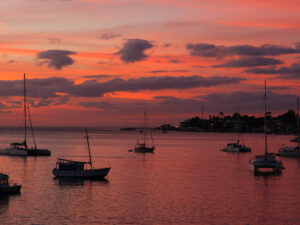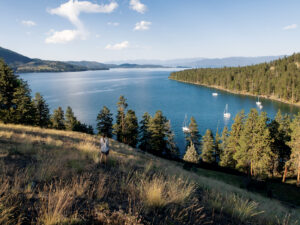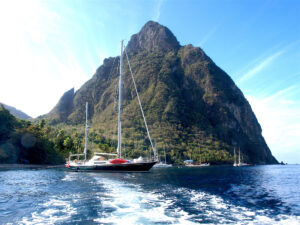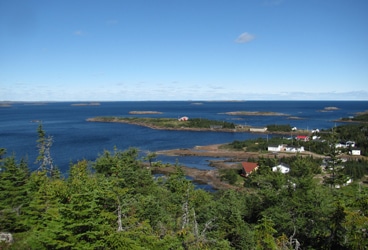
Zartman– Tabatiere
La Tabatiere, which evidently comes from a French word meaning “The Snuffbox,” is the hub of the outport settlements between Cape Whittle and Blanc Sablon. Though the unassuming harbor is completely open to the northeast, a gargantuan wharf built for the ferry has a little nook behind it in which small boats can hide from all weather. We approached this nook with great caution since during our last docking event, at a lonely wharf near St. Agustin where no one goes execpt on ferry days, a combination of strong ebb current and short-lived wind squall had conspired to make me stuff Ganymede’s bowsprit vigorously into the high iron sides of the quay. Usually the bowsprit passes over any normal pier we tie up to, harmlessly sweeping off incautious loafers as I make the final turn, but these fifteen-foot tall commercial wharves are a different story.
There was no excitement this time as we brought Ganymede alongside, and in no time we were made fast, had found an outlet to plug the computer and movie player into, and I was trudging down the road in search of a store. There are rarely stores of different sorts in these parts—if you find a grocery store, chances are it’s also the hardware store, gas station, toy store, home goods, clothing, and will order anything from the Sears catalog. Here the store was mercifully near, but it being a few days since the weekly supply ferry had come, there was not much to choose from. Still, there was ground beef and frozen chicken in which we rejoiced. Better yet, when I asked the clerk whether there was any chance of a laundromat in town, she invited us to wash our clothes at her place after she finished work.
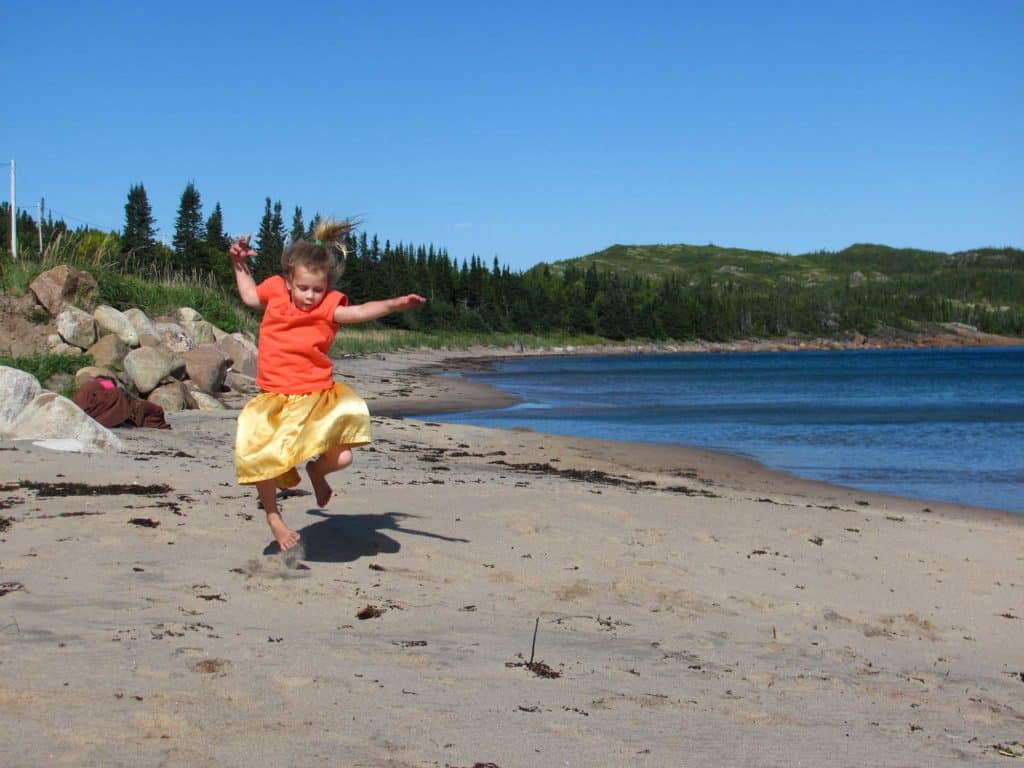
We must have seemed terribly impatient, arriving at what we thought was the appointed time, but which turned out to be an hour early since we’d gone through a time change without knowing it. Still, no harm done, and Janice Robertson took us to her house, got our laundry started, and urged us to take showers. It was strange to think, sitting in her cozy living room with the TV on and surrounded by every conceivable convenience and comfort, that we were in the remotest coast we’d been yet, accessible only by boat—when the ice allowed—and bush plane. But as Janice told us tales of growing up here, the outside world seemed to shrink away. Her grandfather had been postman to the coast, delivering mail by schooner in the summers and dogsled in the winters, as far as Red Bay in Labrador. I shuddered to think of having to negociate that rock-bound coast time and again in an engineless schooner, to say nothing of the Straits of Belle Isle. She herself had been all up and down the coast, riding with her brothers and sisters in their father’s ancient launch though the Little Ree-gullet to visit family in St. Agustin and Riviere St. Paul. It turned out the fur trapper who’d given me a lift in Riviere St. Paul was a close relation to her, which shouldn’t have surprised me—the whole coast’s population is descended from just a few first families.
Winter, she said, was their most social time, when you could drive a pickup truck on the sea ice sometimes all the way from Natashquan, west of Cape Whittle, to the coast of Labrador, and people went back and forth to visit one another and stay in their otherwise inaccessible cottages. It was an altogether instructive evening, and we might have stayed long after the laundry was done and plied Janice with more questions, but the children’s bedtime had come and gone unheeded and it was time to go.
We explored the town a little next day, seeing the old hydroelectric weir that’s been replaced by a far bigger one a few miles off, wondering at the electrical towers that fanned out along the trackless coast (how did they get all that out there? Helicopters?) and tidying up the boat. It always seems a shame to have all clean clothes and selves and not clean the rest of the boat. So while the girls hunted for raspberries I scrubbed the bilges and washed the floor and soon everything felt shiny.
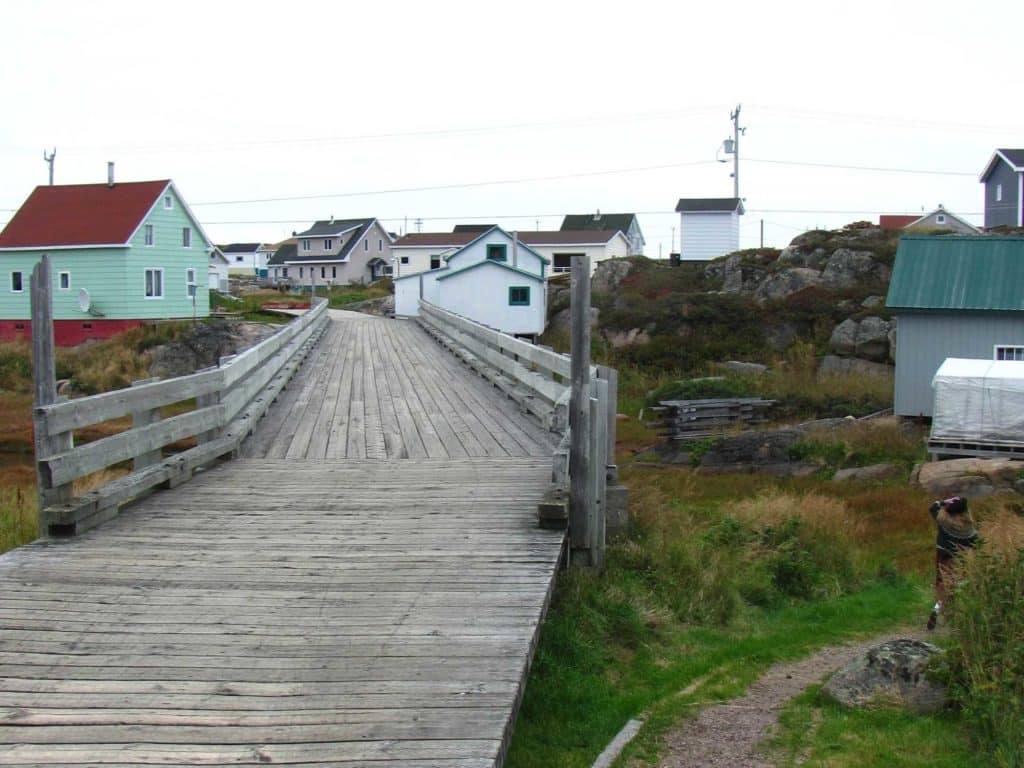
We left on the third morning, obeying our rule of going whenever the wind was fair, and had a nice following breeze all the way to Harrington Harbor, the last village before Cape Whittle had to be got ‘round. There we found a most unique town—it’s on an island too small to bother with roads, so everyone drives around the massive boardwalks on ATVs. It had been ferry day, and everyone was bustling to buy fresh groceries before they were all gone. It was funny to see people hop in a 4-wheeler and drive for a half-minute to avoid a ten-minute walk. It was even funnier to see the grocery store staff taking orders by phone for delivery to someone who was at most a fifteen-minute walk away.
It was chilly, and after a brief explore and some shopping we returned to the boat and lit up the woodstove for a cozy evening, hoping the weather would stay favorable for a long push the following day. We didn’t know how good and how long of a push it would turn out to be, or how close by now we were getting to being just a day or two away from being irretrievably stuck in Canada for the winter. But that will have to wait for another installment.
We are the Zartman family: Ben & Danielle, and our three girls, Antigone, Emily and Damaris. We created this blog to chronicle our sailing adventures on Ganymede, a home-finished 31-foot gaff-rigged cutter, which has been our home since 2009, when we sailed from San Francisco, California, to the Sea of Cortez, then down along the Central American coast.

